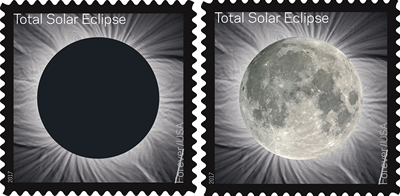
Total Eclipse of the Sun to be commemorated on a Forever Stamp
One Stamp: Two Images
WASHINGTON — The Postal Service will soon release a first-of-its-kind stamp that changes when you touch it. The Total Eclipse of the Sun Forever stamp, which commemorates the August 21 eclipse, transforms into an image of the Moon from the heat of a finger. The public is asked to share the news on social media using the hashtag #EclipseStamps.
Tens of millions of people in the United States hope to view this rare event, which has not been seen on the U.S. mainland since 1979. The eclipse will travel a narrow path across the entire country for the first time since 1918. The path will run west to east from Oregon to South Carolina and will include portions of 14 states.
Thermochromic Ink
The stamp image is a photograph taken by astrophysicist Fred Espenak, aka Mr. Eclipse, of Portal, AZ, that shows a total solar eclipse seen from Jalu, Libya, on March 29, 2006.
In the first U.S. stamp application of thermochromic ink, the Total Eclipse of the Sun Forever stamps will reveal a second image. Using the body heat of your thumb or fingers and rubbing the eclipse image will reveal an underlying image of the Moon (Espenak also took the photograph of the Full Moon). The image reverts back to the eclipse once it cools.
Thermochromic inks are vulnerable to UV light and should be kept out of direct sunlight as much as possible to preserve this special effect. To help ensure longevity, the Postal Service will be offering a special envelope to hold and protect the stamp pane for a nominal fee.
A total eclipse of the Sun occurs when the Moon completely blocks the visible solar disk from view, casting a shadow on Earth. The 70-mile-wide shadow path of the eclipse, known as the “path of totality,” will traverse the country diagonally, appearing first in Oregon (mid-morning local time) and exiting some 2,500 miles east and 90 minutes later off the coast of South Carolina (mid-afternoon local time).
A total solar eclipse provides us with the only chance to see the Sun’s corona — its extended outer atmosphere — without specialized instruments. During the total phase of an eclipse the corona appears as a gossamer white halo around the black disk of the Moon, resembling the petals of a flower reaching out into space.
Art director Antonio Alcalá of Alexandria, VA, designed the stamp.
The Total Eclipse of the Sun stamp is being issued as a Forever stamp, which is always equal in value to the current First-Class Mail 1-ounce price.
The Postal Service receives no tax dollars for operating expenses and relies on the sale of postage, products and services to fund its operations.
A total eclipse of the Sun occurs when the Moon completely blocks the visible solar disk from view, casting a shadow on Earth. The 70-mile-wide shadow path of the eclipse, known as the “path of totality,” will traverse the country diagonally, appearing first in Oregon (mid-morning local time) and exiting some 2,500 miles east and 90 minutes later off the coast of South Carolina (mid-afternoon local time) passing through portions of 14 states.
A total solar eclipse provides us with the only chance to see the Sun’s corona — its extended outer atmosphere — without specialized instruments. During the total phase of an eclipse the corona appears as a gossamer white halo around the black disk of the Moon, resembling the petals of a flower reaching out into space.
Tens of millions of people in the United States hope to view this rare event, which has not been seen on the U.S. mainland since 1979. The eclipse will travel a narrow path across the entire country for the first time since 1918. The back of the stamp pane provides a map of the August 21 eclipse path and times it may appear in some locations. Visit NASA’s website to view detailed maps of the eclipse’s path.
This stamp image is a photograph taken by retired NASA astrophysicist Fred Espenak of Portal, AZ, who is considered by many to be the world’s leading authority on total solar eclipses with 27 under his belt. The photograph shows a total solar eclipse seen from Jalu, Libya, on March 29, 2006.
“I’m honored to have my images on this unique stamp. But more importantly, the stamp will spread the news about America’s great eclipse to many more people than I could ever reach,” said Espenak, who began collecting eclipse stamps after witnessing his first as a teenager. “A total eclipse of the Sun is simply the most beautiful, stunning and awe-inspiring astronomical event you can see with the naked eye — but you’ve got to be in the 70-mile-wide path of totality that runs across the nation from Oregon to South Carolina. So where will you be on August 21?”
“Having witnessed so many total eclipses myself, I know that two minutes inside the moon’s shadow could have a profound impact on the younger generation,” said Guhathakurta. “The Sun can be viewed safely with the unaided eye only during the few brief seconds or minutes of a total solar eclipse. Partial eclipses or partial phases of total solar eclipses are never safe to watch without solar eclipse glasses.”
Guthakurta recommended learning more on solar eclipse safety, educational and science information at eclipse2017.nasa.gov. NASA TVand NASA.gov will broadcast a live panel discussion and news conference starting at 1 p.m. ET Wed. June 21, from the Newseum in Washington, DC.
These new Total Solar Eclipse Stamps are very special to IndianaDG. A solar eclipse is part of the logo adopted by IndianaDG and our mantra:
"Don't let them block the power of the sun."
We hope you will join us in buying and using these new postage stamps.


